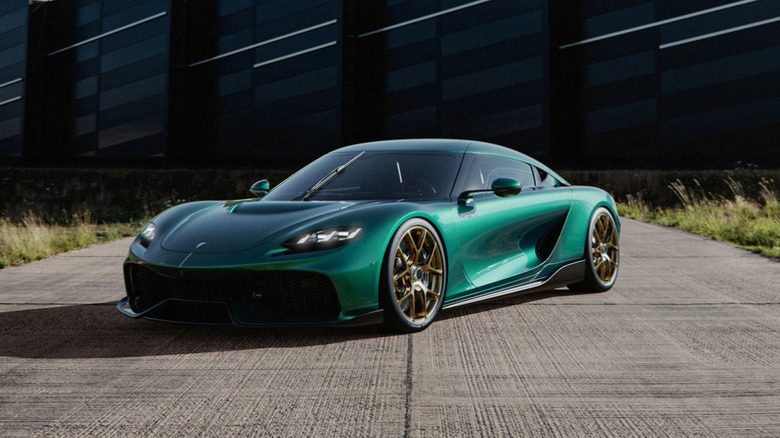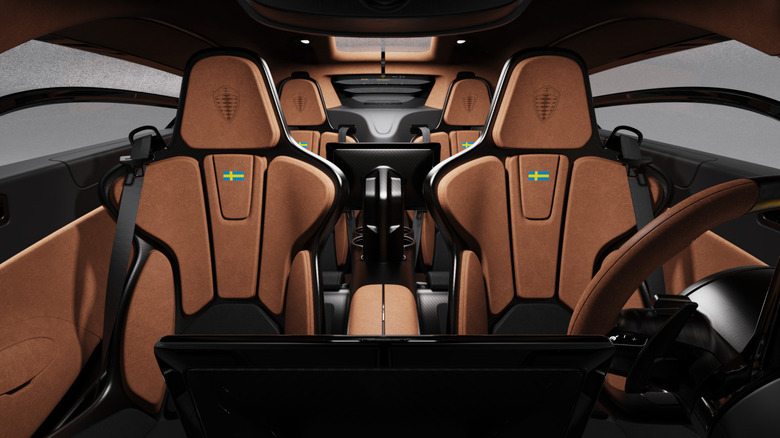This Is The Most HP Ever In A Production Car
Within the automotive industry, tech moves fast. It doesn't seem so long ago that we were all gobsmacked by the Veyron's immense 1,001 horsepower W16 engine. That quad-turbocharged W16 allowed the Bugatti to propel itself to speeds north of 250 mph, finally shattering the Mclaren F1's long standing top speed record. However, fast-forward to today, and there is no shortage of 1,000-horsepower cars on sale. They are no longer seven-figure hypercars either, with four-door EVs such as the Porsche Taycan and Lucid Air now sporting four-figure outputs.
In order to stand out in 2025 and beyond, a whole heap more power is required, and that's exactly what one small and exclusive Swedish automaker has done, by creating the most powerful production car in the world — the Koenigsegg Gemera. Motivating the wheels of Koenigsegg's Gemera is a complex powertrain, consisting of a hot vee V8 engine, or an HV8, and the brand's own Dark Matter electric motor.
The result is a mind-blowing 2,300 horsepower, plus 2,750 newton-meters or torque — roughly 2,028 lb-ft. For a production vehicle, this is a new world record, and 2.3 times greater than what the aforementioned Bugatti stole column inches with when the Veyron dropped around 20 years ago. As impressive as the Gemera's output is, the Koenigsegg's real party piece is something else entirely.
The world's most powerful car is a luxury four-seater with space for luggage
Whether they're hybrids, fully electric, or solely rely on internal combustion, there is one thing that almost all the fastest hypercars have in common; they're all sleek two-seaters. Koenigsegg wanted to break the mold when it developed the Gemera, and so instead of a typical two-seat mid-engine layout, the automaker developed a car which could carry four adults in comfort, and their luggage too.
Koenigsegg states that the rear seats are just as spacious and comfortable as the front seats. All four seats are upholstered with slim microfiber panels, and there are a total of eight cup holders — one heated and one chilled for each occupant. Impressively, the engine is still mid-mounted, and the Gemera boasts a pretty slippery silhouette. The packaging here really is second-to-none, made possible by the HV8's compact dimensions.
This combination of 2,300 horsepower and enough space for four gave Koenigsegg reason to consider they had something truly unique, so instead of dubbing it as merely another super or hypercar, Koenigsegg instead calls the Gemera a megacar. Other megacars from the brand include the CC850 and Jesko. All megacars kick out more than one megawatt of power, and the Gemera is the most powerful of them all.
A closer look at the Koenigsegg's 2,300-HP powertrain
While no doubt the HV8 will find homes in future models from Koenigsegg too, it was first developed with the Gemera in mind. In order to achieve a smaller footprint, Koenigsegg engineers moved the exhaust and turbochargers from the outer flanks of the engine to the very center, in the V — hence the name, hot-vee. Without a doubt, this is one of the most impressive engines in production right now, kicking out up to 1,600 horsepower without any electric assistance.
This gave Koenigsegg the ability to cram its mighty V8 into tighter spaces, namely behind two rows of seats in the Gemera. Koenigsegg then coupled this with its own Light-Speed Tourbillon Transmission, a nine-speed also developed with the Gemera in mind, in addition to the brand's powerful Dark Matter electric motor. By itself, this motor develops 800 horsepower, and is the most powerful automotive-grade electric motor in the industry. The result of all this is Koenigsegg's first four-wheel-drive vehicle with four-wheel torque vectoring, meaning the Gemera can direct those 2,300 horses to wherever the grunt is needed most.


